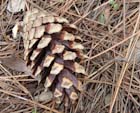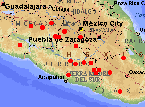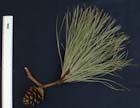
A pure stand in habitat, Cerro de la Cruz, near Uruapan, Michoacán. This could be the type locality [Julio Valdez Partida, 2009].

A tree in habitat, Cerro de la Cruz [Julio Valdez Partida, 2009].

Fallen, open cone, Cerro de la Cruz [Julio Valdez Partida, 2009].

Range of Pinus pringlei (Farjon and Styles 1997). Basemap from Expedia Maps.

Cones on a tree, Cerro de la Cruz [Julio Valdez Partida, 2009].

Needle fascicle, Cerro de la Cruz [Julio Valdez Partida, 2009].

Bark on mature tree, Cerro de la Cruz [Julio Valdez Partida, 2009].

Foliar unit with attached cone, collected Cerro de la Cruz [Julio Valdez Partida, 2009].

Seeds, collected Cerro de la Cruz [Julio Valdez Partida, 2009].

Pinus pringlei
G.R. Shaw ex Sargent 1905
Common names
Pino rojo, pino, ocote (Spanish).
Taxonomic notes
No synonyms, a rarity among Mexican pines. Closely-related species include P. greggii, P. jaliscana, P. oocarpa, P. patula, P. praetermissa, and P. tecunumanii, all of which also are native to Mexico.
Type: Pringle 10019, Michoacán, "hilltops near Uruapán," 1904.10.14.
Description
Trees up to 25 m tall and 100 cm dbh, with a single straight trunk. Bark thick, red-brown to gray-brown, furrowed into small, scaly plates, usually exfoliating on branches. Crown irregular, becoming dome-shaped with age, branches robust, ascending, bearing foliar units at the ends. Twigs thick, stiff, first rough with scale leaves, after first year smoother, waxy, red-brown, ridged, thickening and coarsening with age. Needles in fascicles of (2-)3(-4), (15-)18-25(-30) cm long, 1-1.5 mm thick, stiff, lasting 2-3 years, bright green. Stomata on all faces, (3-)4-7(-9) resin canals, mostly internal, sometimes medial or septal. Fascicle sheath 12-20 mm long, persistent. Pollen cones 15-25 × 8 mm, yellow-brown at maturity. Seed cones semi-serotinous, 5-8(-10) cm long, ovoid, with 70-100 seed scales, green, ripening shiny brown, gradually opening from the tip toward the base, leaving a few scales on the branch when they fall. Seed scales with a small, low umbo bearing a minute, fragile prickle. Seeds 4-6 mm with a 12-18 mm wing (Farjon and Styles 1997, Eckenwalder 2009, pers. obs. 2005).
Distribution and Ecology
Mexico: Michoacán, Morelos, México, Guerrero and Oaxaca; perhaps in W Puebla (Farjon and Styles 1997). See also Thompson et al. (1999).
Distribution data from USGS (1999). Points represent isolated or approximate locations.
Zone 9 (cold hardiness limit between -6.6°C and -1.1°C) (Bannister and Neuner 2001).
Remarkable Specimens
Ethnobotany
Observations
Remarks
This species is a principal host to the dwarf mistletoe Arceuthobium globosum subsp. grandicaule (Hawksworth and Wiens 1996).
Named for Cyrus G. Pringle (1838-1911), who collected the type (Eckenwalder 2009).
Citations
Sargent, C.S. 1902-1913. Trees and shrubs, illustrations of new or little known ligneous plants. Vol. I parts 2, 4. Boston: Houghton Mifflin.
See also
Dvorak, W.S., P. Kikuti, and I. Fier. 2000. Pinus pringlei. Pp. 174-187 in Conservation & Testing of Tropical & Subtropical Forest Tree Species by the CAMCORE Cooperative. Raleigh, NC: College of Natural Resources, NCSU.









